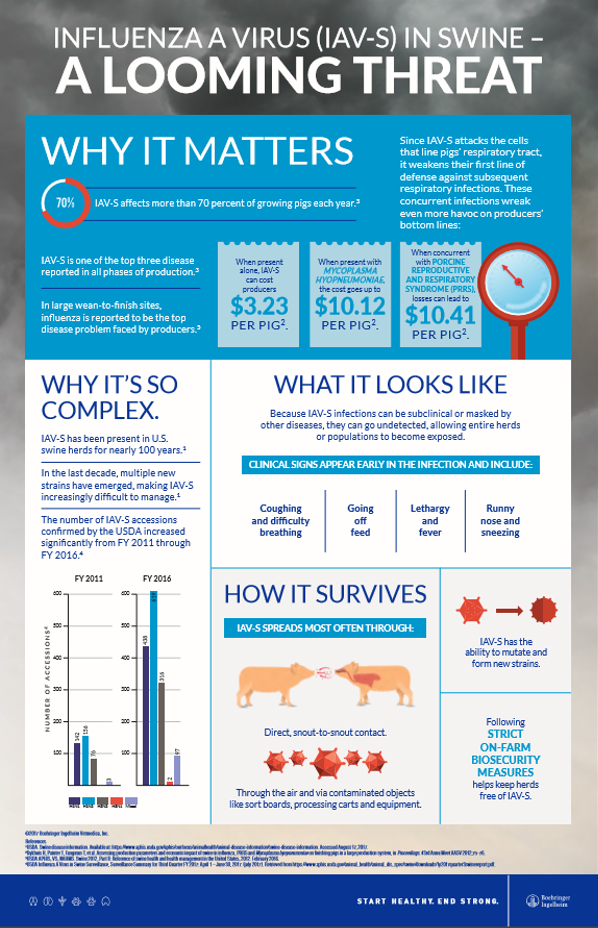



Influenza: a growing threat to your swine herd
Influenza A virus in swine has an endemic presence in swine populations across North and South America, Asia and Europe. Now, with the emergence of new virus strains that are more difficult to predict and control, IAV-S has emerged as a major threat to the industry overall. It is important to know the facts and raise awareness within the pig industry to help in the prevention of further outbreaks.The threat of Influenza A virus in swine (IAV-S) is most obvious when consulting data on the production losses associated with the virus. A 2012 case study, that looked at losses associated with average daily gain, culls and mortality rates among hogs with IAV-S, estimated that the virus, when present alone, cost the producer $3.23 per head (Dykhuis Haden, 2012).
More commonly, IAV-S exists concurrently with other diseases, with synergistic effects. One of the effects of IAV-S is that it attacks the cells that line the respiratory tract of pigs, weakening their first line of defense against subsequent respiratory infections. The 2012 (Dykhuis Haden) study found that, when IAV-S was present with Mycoplasma hyopneumoniae, it led to even greater production losses that totaled $10.12 per head. Further, when present with porcine reproductive and respiratory syndrome (PRRS), it cost the producer $10.41 per head.
Unfortunately for producers, these concurrent infections are all too common, Christa Goodell, Technical Manager at Boehringer Ingelheim, comments:
It’s not common to find IAV-S by itself in swine.
More often, it’s going to be present with other pathogens in the porcine respiratory disease complex. So, you have multiple respiratory pathogens affecting the pig at the same time, which can make diagnosing and treating them extremely difficult.
Clinical Signs of IAV-S
Recognizing IAV-S in a herd is the first step to addressing it. Dr Amy Vincent, Research Veterinary Medical Officer, USDA Agricultural Research Service, describes the clinical signs to look out for:
It’s well-known that influenza A virus in swine (IAV-S) is one of the viral pathogens that can modulate the immune system, and so it sets up the respiratory tract to be more susceptible to secondary bacterial infection following an IAV-S infection.
Oftentimes, IAV-S has a very rapid onset, within 24-48 hours you’ll start seeing the typical signs of respiratory illness including fever, runny nose and eyes, cough, lethargy, decrease in appetite, etc. These signs usually last about a week. However, during the following weeks is when producers should be on the lookout for secondary bacterial infections.
It is important to note that IAV-S is not a disease that gets into the blood, and therefore is not passed on to pigs in utero or through milk.
Transmission of IAV-S
Dr Tara Donovan, Vice President of Health Management, The Hanor Company, explains the transmission pathway of IAV-S:
There are two ways that IAV-S can spread – lateral transmission or pig to pig transmission:
- Lateral transmission is from one group of pigs to another group of pigs. These pigs might be housed a half a mile apart and never really have contact with each other. In a pig-dense area where there’s multiple barns that are in close proximity to each other, the pigs can come in either negative or protected, meaning their mothers were vaccinated, they are not shedding IAV-S, and there are no clinical signs of disease. However, because it’s aerosol transmitted, they are at high risk for getting infected laterally from a neighbouring barn.
- The other type is pig to pig transmission, which occurs when the sow is IAV-S positive and infects her litter through shedding the virus in the farrowing house through direct contact. Studies have shown that IAV-S can be in a farrowing house for a long time, at a low level, and continually spread from pig to pig.
IAV-S is aerosol, and that’s hard to control. We don’t have the tools to control it, or at least not inexpensive, economically feasible tools. So, we’ve gone the route of protecting the pigs with vaccines, knowing that they have high risk of getting infected.
The peak time for transmission occurs within the first 48 hours. IAV-S spreads most often through direct, nose-to-nose, contact between pigs, through the air and via contaminated objects like sort boards, processing carts and equipment.
The virus commonly infects pigs in all stages of production, but is found particularly in early nursery when pigs are weaned and comingled, late nursery, as maternal antibodies wane, or in the grow-finish phase in swine dense areas or continuous flow sites; but pigs of any age are susceptible.
Additionally, because IAV-S infections can often be subclinical or have co-infections, they can go undetected until entire sites have been exposed.
Not only can the virus spread quickly, it has the ability to mutate and form new strains. In the last 20 years, multiple new strains have emerged, which has caused IAV-S to become increasingly difficult to manage, and achieving solid cross-protection against such a dynamic threat is difficult (USDA, 2017).
One of the challenges of combating IAV-S lies in educating people within the industry of the facts surrounding the virus - clinical signs, transmission routes, and understanding why it is so important to stop its spread. Boehringer Ingelheim have produced an infographic, available for dispersal on request:

Christa Goodell recommends talking with your veterinarian about IAV-S, or to learn more, click here
Boehringer Ingelheim









